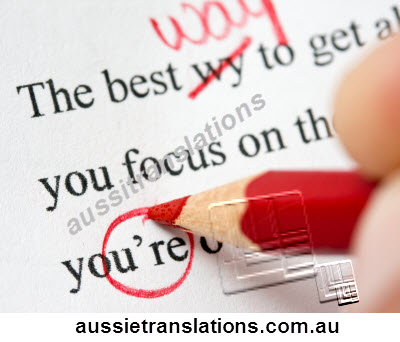 Clients are not always best placed to spot errors in translation. They rely on the professional translator to do a good job and don’t expect they have to proofread what has been translated. After all, if they could translate the document, manual or website themselves then they wouldn’t need a translation services provider! It is usually down to the proofreader to check that a translation is up to scratch and is suitable for sending on to the client. In fact, proofreading services are just as important as translation services and no doubt every proofreader has saved the day by spotting glaring errors in translation that have come their way. Here are five terrible mistakes that a proofreader often has to correct.
Clients are not always best placed to spot errors in translation. They rely on the professional translator to do a good job and don’t expect they have to proofread what has been translated. After all, if they could translate the document, manual or website themselves then they wouldn’t need a translation services provider! It is usually down to the proofreader to check that a translation is up to scratch and is suitable for sending on to the client. In fact, proofreading services are just as important as translation services and no doubt every proofreader has saved the day by spotting glaring errors in translation that have come their way. Here are five terrible mistakes that a proofreader often has to correct.
Literally translating an acronym
Many commonly used acronyms are quite different in different languages and it is important to get the translated, correct terms right. An example is the English “Co. Ltd.” This is translated in Indonesian / Malay as Sdn. Bhd. (Sendirian Berhad), which is not a strict translation of the English but is what is commonly used in these two countries. These sorts of differences will come up a lot on business document translations so it is important to have a working knowledge of acronyms and abbreviations that are commonly used in the target language.
Overuse of Capital Letters
While capital letters may be fine in a title or heading, they can easily be overused for emphasis in a translated text. Also, there may be a tendency to use capitals in English, for instance, when the words being translated naturally and correctly have capitals because that is what is normal in that language. If This Doesn’t Seem a Sensible use of Capitals in This Sentence, it won’t be appreciated by the person for whom the translation is intended, either.
Incorrect use of Singular and Plural
The incorrect use of singular and plural forms of a noun is a common but unacceptable translation error. It usually follows on from differences in the use of the plural form in the source language. This is very commonly noticed when a piece of text or document has been translated from a language in which the singular and plural form of a noun are the same and there are other ways of denoting multiplicity. Sloppy translation, even by a native speaker of a language, can result in a document appearing to have been translated by a non native speaker.
Not translating a complex word or phrase
This is a translation error that results from coming across a term that is specific to that language and cannot be easily translated into the target language. The easy way out is to leave the word as it is in the hope that it is understood by the reader of the translated text. This is unlikely and the only solution is to find out exactly what the term means even if it means spending a bit of time doing a search on the internet and making a proper translation.
Overuse of hyphenation
Again, this is a common error that can follow on from the use of hyphenation in the language being translated. Some languages, such as German, have a lot of naturally hyphenated words or phrases, but these don’t translate into English necessarily as hyphenated translations. In fact the general rule of hyphenation in English is to use hyphenation as little as possible – only when confusion might result from the lack of a hyphen.



